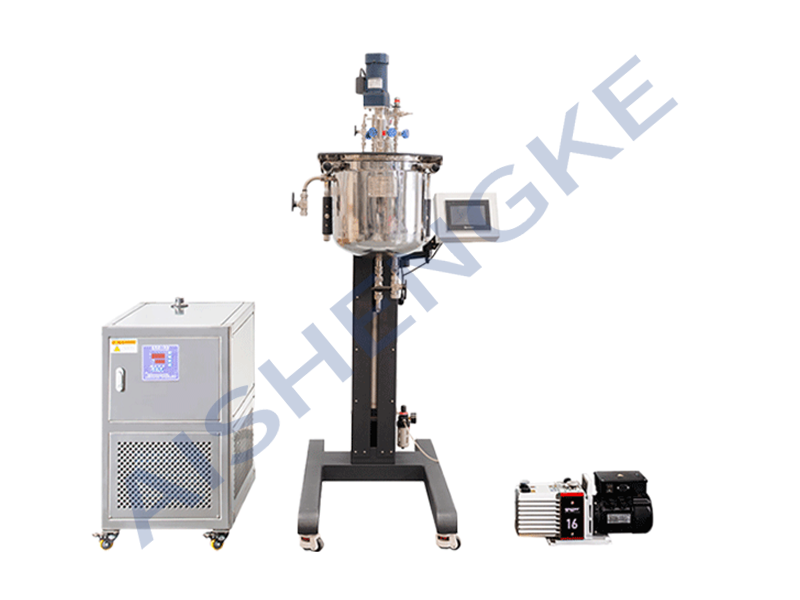The principle and characteristics of stainless steel reactor
Release Time:
2022-11-04
Pageviews:
Atmospheric pressure stainless steel electric heating reaction kettle has the characteristics of rapid heating, high temperature resistance, corrosion resistance, sanitation, no environmental pollution, electric heating stainless steel reaction kettle, no need for automatic heating by boiler, convenient use and low price. Widely used in chemical, pharmaceutical, food and other industries, the material is 304 stainless steel.

The structure principle and characteristics of the reaction kettle: the reaction kettle is composed of the pot body, the pot cover, the stirrer, the jacket, the support and transmission device, the shaft seal device, etc. The material and opening can be made according to the user's process requirements. Heating forms include electric heating, oil heating, gas heating, water heating (or cooling), and open flame heating. The jacket type is divided into: jacket type and outer half-pipe type, and the jacket oil heating type is equipped with a diversion device. The stirring forms generally include paddle type, anchor type, frame type, ribbon type, wall scraping type, etc. High-speed types include dispersed impeller type, turbine type, high shear type and propeller type, for customers to choose according to the process. The transmission forms include ordinary motors, explosion-proof motors, electromagnetic speed-regulating motors, frequency converters, etc. The reducers include cycloidal pinwheel type, worm gear type, and planetary stepless speed change type. Shaft seals are ordinary water cooling packing seals, combined tetrafluoro packing seals and mechanical seals. The discharge forms include ball valve and downward expansion valve.
Latest News
2024-09-03
Abstract: Oil deacidification is an important step in food processing, which aims to remove free fatty acids in oil and improve its quality and stability. Traditional deacidification methods have some limitations, such as low efficiency, high energy consumption, and loss of nutrients. In recent years, molecular distillation technology has gradually attracted attention as a new deacidification method. This article will introduce the application of molecular distillation in oil deacidification, including the principle, operation process and advantages, and focus on the outstanding advantages of Aishengke in molecular distillation technology.
Vitamins are products that are closely related to people's lives, and have become one of the main bulk products in the international pharmaceutical and health care products market. The amount of vitamin E is the largest, followed by vitamin A, vitamin C, vitamin D and so on. With the growth of economy and the improvement of people's living standards, the demand for vitamin products will further increase, and people's requirements for their quality and grade will also further increase. Therefore, as an important separation technology in the production of many vitamins, molecular Distillation technology will also play an increasingly important role in the vitamin industry.
Glyceryl monostearate (GMS), abbreviated as monoglyceride, is produced from natural vegetable oils and fats. The active ingredient is purified by molecular distillation technology to more than 90%, also known as molecular distillation monoglyceride. It is the most widely used food Additives, safe to use in the production and processing of food, medicine, plastics, etc., account for more than half of the emulsifier consumption in the market.
The principle of molecular distillation is to make use of the different degrees of affinity between different molecules. By controlling the conditions such as temperature and pressure, the mixture begins to vaporize. Different components in the vapor form liquids in the condenser and are separated according to their boiling points. This distillation method not only has a good separation effect, but also can be repeatedly separated and purified, and is widely used in chemical, pharmaceutical and other fields.
Molecular distillation is a common chemical method used to separate and purify compounds. In the pharmaceutical industry, molecular distillation is widely used in pharmaceutical purification. This article will focus on the application of molecular distillation in pharmaceutical purification and provide some specific examples.
Laboratory vacuum distillation equipment has undergone significant advancements in recent years, driven by the need for higher efficiency, improved safety, and enhanced user experience.
Global recruitment of distributors
If you recognize the brand, technology, products and market prospects of Aishengke, we look forward to establishing a strategic partnership with you for win-win cooperation and development. Looking forward to your joining!

